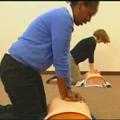
02 Apr Hands-Only CPR Increases Bystander Participation and Survival After Cardiac Arrest
MedicalResearch.com Interview with:

Hands only CPR
AHA image
Gabriel Riva, Graduate Student
Department of Medicine, Solna (MedS),
Karolinka Institute
MedicalResearch.com: What is the background for this study? What are the main findings?
Response: During the last decade there has been a gradual adoption of compression-only CPR, as an option to conventional CPR with chest compressions and rescue breaths, in international CPR guidelines. The simplified technique is recommended for bystanders who are untrained and in “telephone assisted CPR”. One of the reasons was the assumption that more people would actually do CPR with the simplified technique. We could in this nationwide study running over 3 guideline periods demonstrate a 6-fold higher proportion of patients receiving compression-only CPR and a concomitant almost doubled rate of CPR before emergency medical services arrival over time. This very large increase in simplified CPR was surprising to us, especially considering there has never been any public campaigns promoting compression-only CPR in Sweden and training still include compressions and ventilations.
New first aid certified students will go through these updates to ensure the best possible assistance for emergencies.
MedicalResearch.com: What should readers take away from your report?
Response: Bystanders play a vital role in out of hospital cardiac arrest, their actions can be lifesaving. CPR performed by bystanders before emergency services arrival is one of the most important factors and can double the chance of survival.
MedicalResearch.com: What recommendations do you have for future research as a result of this work?
Response: Although we observed higher CPR rates at the end of the study period, 1/3 of all witnessed OHCA did still not receive any intervention before emergency medical services arrival in the last time-period. This leaves a large room for improvement (especially for OHCA occurring in homes). How to increase CPR rates for those victims is one issue.
Also, randomized, controlled trials are needed to answer the question of whether compression-only CPR is non-inferior to CPR with compression and ventilation when the bystanders has previous CPR training. In Sweden, a large RCT is currently ongoing trying to answer this question.
MedicalResearch.com: Is there anything else you would like to add?
Response: CPR in its simplest form is only chest compressions. Doing chest compressions doubles the chance of survival compared to doing nothing. I believe this message is clear enough, encouraging people to participate in a CPR course is absolutely reasonable.
Citation:
Gabriel Riva, Mattias Ringh, Martin Jonsson, Leif Svensson, Johan Herlitz, Andreas Claesson, Therese Djärv, Per Nordberg, Sune Forsberg, Sten Rubertsson, Anette Nord, Mårten Rosenqvist, Jacob Hollenberg. Survival in Out-of-Hospital Cardiac Arrest After Standard Cardiopulmonary Resuscitation or Chest Compressions Only Before Arrival of Emergency Medical Services: Nationwide Study During Three Guideline Periods. Circulation, 2019; DOI: 10.1161/CIRCULATIONAHA.118.038179
[wysija_form id=”3″]
[last-modified]
The information on MedicalResearch.com is provided for educational purposes only, and is in no way intended to diagnose, cure, or treat any medical or other condition. Always seek the advice of your physician or other qualified health and ask your doctor any questions you may have regarding a medical condition. In addition to all other limitations and disclaimers in this agreement, service provider and its third party providers disclaim any liability or loss in connection with the content provided on this website.
Last Updated on October 17, 2024 by Marie Benz MD FAAD
